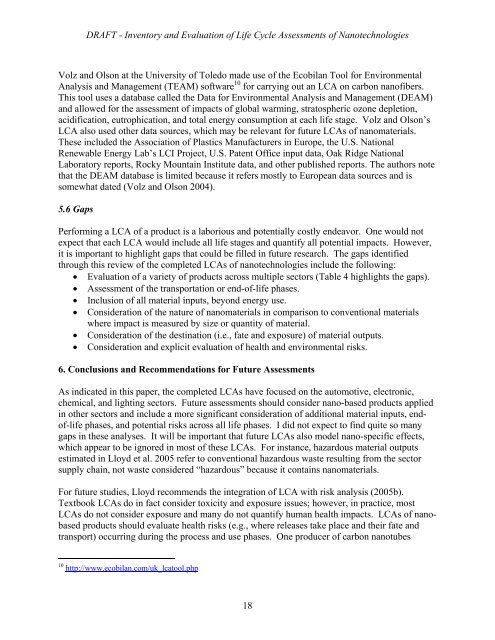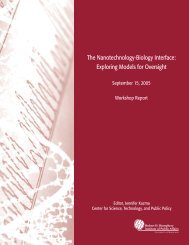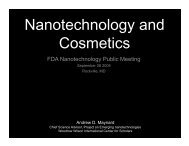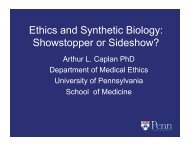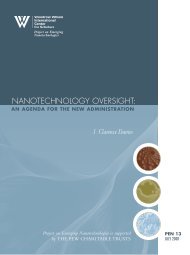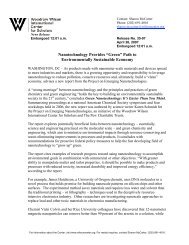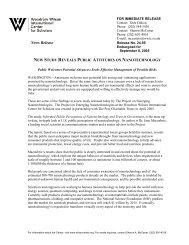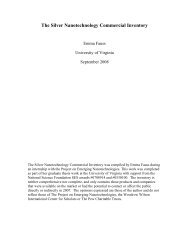Analysis of Nanotechnology from an Industrial Ecology ... - denix
Analysis of Nanotechnology from an Industrial Ecology ... - denix
Analysis of Nanotechnology from an Industrial Ecology ... - denix
You also want an ePaper? Increase the reach of your titles
YUMPU automatically turns print PDFs into web optimized ePapers that Google loves.
DRAFT - Inventory <strong>an</strong>d Evaluation <strong>of</strong> Life Cycle Assessments <strong>of</strong> N<strong>an</strong>otechnologies<br />
Volz <strong>an</strong>d Olson at the University <strong>of</strong> Toledo made use <strong>of</strong> the Ecobil<strong>an</strong> Tool for Environmental<br />
<strong>Analysis</strong> <strong>an</strong>d M<strong>an</strong>agement (TEAM) s<strong>of</strong>tware 10 for carrying out <strong>an</strong> LCA on carbon n<strong>an</strong><strong>of</strong>ibers.<br />
This tool uses a database called the Data for Environmental <strong>Analysis</strong> <strong>an</strong>d M<strong>an</strong>agement (DEAM)<br />
<strong>an</strong>d allowed for the assessment <strong>of</strong> impacts <strong>of</strong> global warming, stratospheric ozone depletion,<br />
acidification, eutrophication, <strong>an</strong>d total energy consumption at each life stage. Volz <strong>an</strong>d Olson’s<br />
LCA also used other data sources, which may be relev<strong>an</strong>t for future LCAs <strong>of</strong> n<strong>an</strong>omaterials.<br />
These included the Association <strong>of</strong> Plastics M<strong>an</strong>ufacturers in Europe, the U.S. National<br />
Renewable Energy Lab’s LCI Project, U.S. Patent Office input data, Oak Ridge National<br />
Laboratory reports, Rocky Mountain Institute data, <strong>an</strong>d other published reports. The authors note<br />
that the DEAM database is limited because it refers mostly to Europe<strong>an</strong> data sources <strong>an</strong>d is<br />
somewhat dated (Volz <strong>an</strong>d Olson 2004).<br />
5.6 Gaps<br />
Performing a LCA <strong>of</strong> a product is a laborious <strong>an</strong>d potentially costly endeavor. One would not<br />
expect that each LCA would include all life stages <strong>an</strong>d qu<strong>an</strong>tify all potential impacts. However,<br />
it is import<strong>an</strong>t to highlight gaps that could be filled in future research. The gaps identified<br />
through this review <strong>of</strong> the completed LCAs <strong>of</strong> n<strong>an</strong>otechnologies include the following:<br />
• Evaluation <strong>of</strong> a variety <strong>of</strong> products across multiple sectors (Table 4 highlights the gaps).<br />
• Assessment <strong>of</strong> the tr<strong>an</strong>sportation or end-<strong>of</strong>-life phases.<br />
• Inclusion <strong>of</strong> all material inputs, beyond energy use.<br />
• Consideration <strong>of</strong> the nature <strong>of</strong> n<strong>an</strong>omaterials in comparison to conventional materials<br />
where impact is measured by size or qu<strong>an</strong>tity <strong>of</strong> material.<br />
• Consideration <strong>of</strong> the destination (i.e., fate <strong>an</strong>d exposure) <strong>of</strong> material outputs.<br />
• Consideration <strong>an</strong>d explicit evaluation <strong>of</strong> health <strong>an</strong>d environmental risks.<br />
6. Conclusions <strong>an</strong>d Recommendations for Future Assessments<br />
As indicated in this paper, the completed LCAs have focused on the automotive, electronic,<br />
chemical, <strong>an</strong>d lighting sectors. Future assessments should consider n<strong>an</strong>o-based products applied<br />
in other sectors <strong>an</strong>d include a more signific<strong>an</strong>t consideration <strong>of</strong> additional material inputs, end<strong>of</strong>-life<br />
phases, <strong>an</strong>d potential risks across all life phases. I did not expect to find quite so m<strong>an</strong>y<br />
gaps in these <strong>an</strong>alyses. It will be import<strong>an</strong>t that future LCAs also model n<strong>an</strong>o-specific effects,<br />
which appear to be ignored in most <strong>of</strong> these LCAs. For inst<strong>an</strong>ce, hazardous material outputs<br />
estimated in Lloyd et al. 2005 refer to conventional hazardous waste resulting <strong>from</strong> the sector<br />
supply chain, not waste considered “hazardous” because it contains n<strong>an</strong>omaterials.<br />
For future studies, Lloyd recommends the integration <strong>of</strong> LCA with risk <strong>an</strong>alysis (2005b).<br />
Textbook LCAs do in fact consider toxicity <strong>an</strong>d exposure issues; however, in practice, most<br />
LCAs do not consider exposure <strong>an</strong>d m<strong>an</strong>y do not qu<strong>an</strong>tify hum<strong>an</strong> health impacts. LCAs <strong>of</strong> n<strong>an</strong>obased<br />
products should evaluate health risks (e.g., where releases take place <strong>an</strong>d their fate <strong>an</strong>d<br />
tr<strong>an</strong>sport) occurring during the process <strong>an</strong>d use phases. One producer <strong>of</strong> carbon n<strong>an</strong>otubes<br />
10 http://www.ecobil<strong>an</strong>.com/uk_lcatool.php<br />
18


